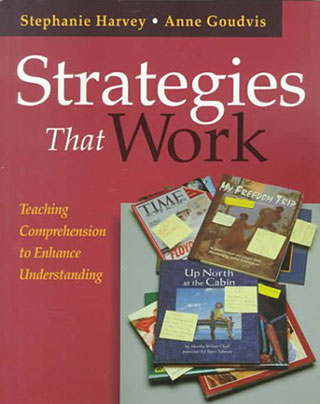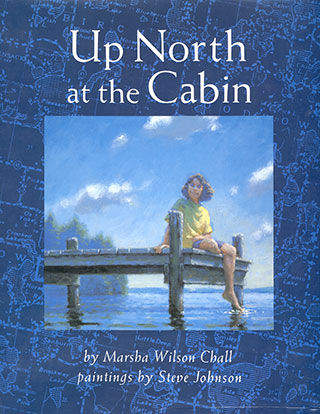Strategic Thinking
Below is the introduction to a text by Stephanie Harvey and Anne Goudvis called Strategies That Work: Teaching Comprehension to Enhance Understanding, First Edition, pages 3–4. Stenhouse Publishers, 2000.
Thirty sixth graders crowd onto a woven area rug in the reading corner. A brass floor lamp casts a warm, amber glow onto their faces. Steph takes a seat in the rocking chair in front of them. “Today I am going to read you a picture book called Up North at the Cabin by Marsha Wilson Chall. I wish I had written it. I’ll tell you why. This book reminds me exactly of my own childhood. It is the story of a young girl about your age who left the city every summer to spend time in a cabin on a lake in Minnesota. Minnesota is called the Land of Ten Thousand Lakes. I grew up in the neighboring state of Wisconsin. We had our share of lakes, too,” Steph tells them as she points out the location of these two upper-Midwestern states on the wall map.
“Writers write best about things they know and care about,” Steph says. She reads from the inside flap that the author spent her summers on northern lakes and was inspired by her own experience as a child and later on as a mother when she returned to this cabin with her own children. “I was a kid who loved summers,” Steph says while a dozen heads nod in agreement. “Like the young girl in the book, I spent summers on a lake where we fished, swam, water-skied, hiked and canoed.” Steph mentions how fortunate she feels that Marsha Chall wrote a book with which she identifies so closely. “Have you ever read a book that reminds you of your own life?” she asks. Hands wave wildly as kids share their favorites.
“Koala Lou,” [Mem Fox, 1988], Shelby bursts out. “I have a whole bunch of brothers and sisters and sometimes I get really jealous of them just like Koala Lu did.”
“I Hate English,” [Levine, 1989], Jen-Li chimes in. “I couldn’t understand a word of English when I first came from Korea. School was really hard. I know exactly how that girl felt.”
Steph points out that Shelby and Jen-Li have made a connection between books and their lives. “If we connect to a book, we usually can’t put it down. Good readers make connections between the texts they read and their own lives. Let’s try something. I am going to read you Up North at the Cabin. As I read the words, I am going to show you the thinking that is going on in my head. I’ll use these sticky notes to jot that thinking down and mark a connection. I’ll mark the sticky note with the code T‑S for text-to-self connection because it reminds me in some way of my own life and prior experience. Then I’ll place the sticky note on the appropriate passage or picture. I’ll let it stick out of the book a little, like a bookmark, so I can find it easily if I want to come back to it later on.”
Steph reads through the book page by page sharing her thinking about waterskiing, the local bait shop, pruney fingers from too much swimming, and portaging canoes. She marks the text and illustrations with sticky notes coded T‑S and jots down a few words such as, “Sometimes we even used peanut butter for bait when we ran out of night crawlers” or “Boy, was I mad when my dad made me carry that canoe.”
When she comes to a page that shows the main character in an orange canvas life jacket with two white button closures, she laughs and stops to share a brief story. “I can’t help but think of my mom when I see this orange life jacket. There were five of us kids, and we lived right on the edge of the water. When we were toddlers, my mom was wracked with worry that one of us might fall into the lake and drown. Her solution: the day we started to walk, she wrapped us in those orange life jackets. We wore them everywhere. We ate our cereal in them. We watched TV in them. Sometimes, we even slept in them. We looked like five little bulldozers!” Two kids in front grab the book to take a closer look at the tell-tale life jacket.
“How embarrassing,” Josh murmurs.
“You’d better believe it. But I think mom was onto something. We learned to swim quicker than any kids around just to get rid of those goofy life jackets!”
When Steph finishes reading out loud, she encourages kids to find a book they connect with and to use sticky notes to mark their text-to-self connections and jot down their thinking. We urge teachers to do the same. Find that book you relate to above all others, your connection book. Unless you are one of Steph’s life jacket-bound siblings or a Wisconsin ice fisherman, it may not be Up North at the Cabin. Read it to your students, sharing your connections as you read. There is nothing more powerful than a literacy teacher sharing her passion for reading, writing, and thinking. Passion is contagious. Kids will respond.


